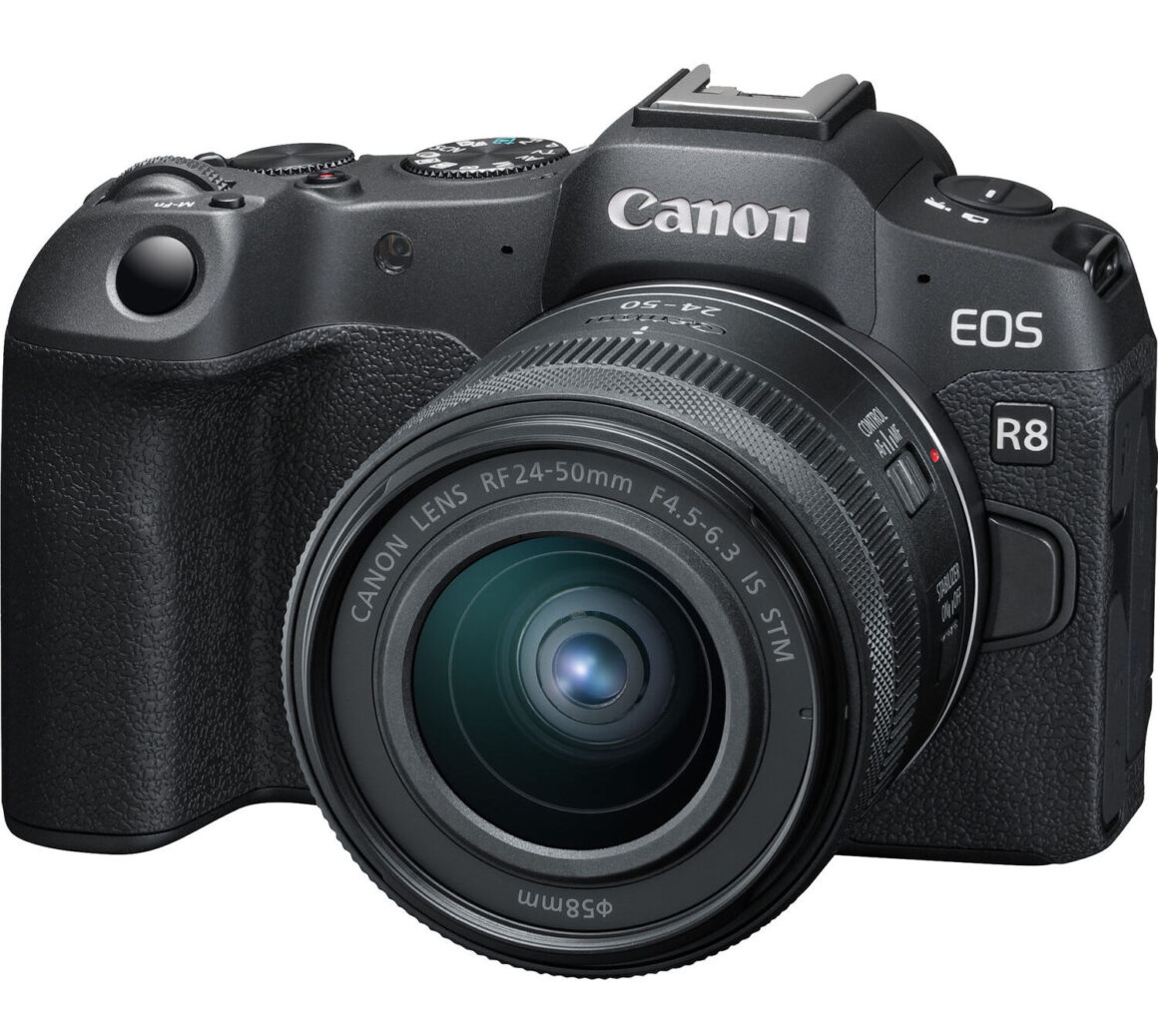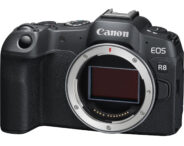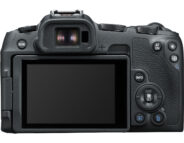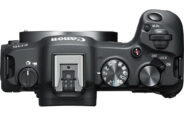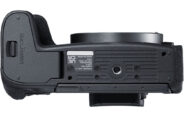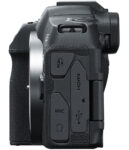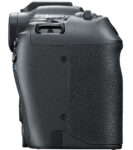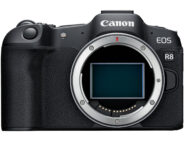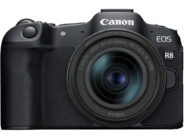Canon EOS R8
35mm AF digital mirrorless camera
Specification
| Production details: | |
| Announced: | February 2023 |
| System: | ● Canon EOS R (2018) |
| Format: | |
| Maximum format: | 35mm full frame |
| Imaging sensor: | 36 × 24mm CMOS sensor |
| Resolution: | 6000 × 4000 - 24 MP |
| Sensor-shift image stabilization: | Yes |
| Mount and Flange focal distance: | Canon RF [20mm] |
| Shutter: | |
| Type: | Focal-plane |
| Model: | Electronically controlled |
| Speeds: | 30 - 1/16000 + B |
| Exposure: | |
| Exposure metering: | Through-the-lens (TTL), open-aperture |
| Exposure modes: | Programmed Auto |
| Aperture-priority Auto | |
| Shutter-priority Auto | |
| Manual | |
| Physical characteristics: | |
| Weight: | 414g |
| Dimensions: | 132.5x86.1x70mm |
Manufacturer description #1
MELVILLE, NY, February 7, 2023 – Canon U.S.A., Inc., a leader in digital imaging solutions, announced today the launch of the new EOS R50 camera body, ideal for entry level users, and the EOS R8, an extremely compact, full-frame camera aimed at advanced amateur photo and video enthusiasts looking for budget-friendly options that don't sacrifice performance. Additionally, two new RF-Mount lenses are being introduced to the ever-growing R-mount lens lineup.
EOS R50
Compact, lightweight and ideal for those looking to step up their video quality, the EOS R50 provides an impressive movie-shooting experience thanks to the APS-C sensor, with 4K video, uncropped 4K capture (at all frame rates), and outstanding Dual Pixel CMOS AF technology. With the addition of whole area tracking, subject detection, and movie-prerecording, difficult photo and movie opportunities can be easier to capture with a 24.2-million-pixel, APS-C sized image sensor. In addition, the EOS R50 is equipped with an eye-level electronic viewfinder to help achieve shot steadiness and ease viewing in bright sunlight conditions. A great camera for those who are looking to lean into interchangeable lenses, the EOS R50 camera can capture travel adventures, family portraits, sports, wildlife and even help a small business with marketing imagery. For those who are budding content creators, the EOS R50 will be available later in 2023 as part of a Content Creator Kit – packaged with a microphone, lens and grip. Overall, the EOS R50 is truly a jack of all content creation trades.
“The first time I picked up the EOS R50, I noticed how light it was. When I saw the footage, I wondered how the quality can be so good when it’s this lightweight in my hand. My mind was blown!” Bianca Matisse Taylor – Content creator and blogger.
EOS R8
The EOS R8 — affordable and functional — is a full-frame mirrorless camera aimed at the up-and-coming video or photo enthusiast. This camera comes with class-leading autofocus while still extremely capable for everyday and general photography use. Equipped with a 24.2-megapixel CMOS image sensor and DIGIC X image processor, the EOS R8 is optimal for full-frame RF lenses — allowing enhanced wide-angle field of views when compared to APS-C sensor cameras. Extremely lightweight and compact, the EOS R8 shoots up to 6-fps with 1st-curtain Electronic shutter, and up to 40-fps with full electronic. For users who've already explored interchangeable lens cameras but haven't yet broken into mirrorless, the EOS R8 should be the camera that takes them over the threshold to capture events, weddings, still life, travel and pets.
“My work is a lot about movement and not missing a beat with the fast shutter on the EOS R8 is so important to me as an artist.” Jasper Soloff – Photographer and Director.
Additional product specs include:
Video performance
- Uncropped 4K video to 59.94p (29.97p with EOS R50) (with 6k oversampling)
- Full-HD to 59.94 fps, and High Frame Rate to 119.8 fps (Full HD 180p with the EOS R8)
- Dual Pixel CMOS AF, with subject detection for people, animals and vehicles
- Up to 2 hours of continuous recording (one hour with EOS R50); no 30 min limit
- Focus breathing correction
Enhanced usability for video correction
- Vertical Video Metadata
- Movie Self Timer
- Audio Noise Reduction (only in EOS R8)
- UVC/UAC Support, for USB livestreaming
- Recording Emphasis
- Aspect Markers
Connectivity
- Easy wireless connection from camera to compatible smartphone
- Camera Connect with USB connection to compatible smartphone
- USB streaming direct to computer via Zoom™, Teams™, or Skype™
- MFI Certified (Apple); WPA3-Personal protected access
- Convenient firmware updates via compatible smartphone
- Cloud RAW processing
Alongside the camera bodies, Canon will release two new lenses. The RF-S lens line, optimized for the smaller APS-C sensor size, expands with the Canon RF-S55-210mm F5-7.1 IS STM lens. This is a telephoto zoom, giving coverage equivalent to an 88–336mm lens on a full-frame camera. The lens opens the door to telephoto photography and videography, with 4.5 stops optical image stabilization, and close-focusing that can fill the frame with a subject roughly 2x3 inches in size (at its 210mm zoom setting, and minimum focus distance). And it does all this in an incredibly lightweight and compact package.
The Canon RF24-50mm F4.5-6.3 IS STM is a new, compact standard zoom lens for full-frame EOS R-series cameras. Ranging from true wide-angle to traditional “standard lens” coverage at 50mm, the lens is a travel friendly design with an extremely compact exterior. The RF24-50mm F4.5-6.3 IS STM lens is just over 2 inches long when fully retracted, and under 3.5 inches when extended — weighing less than half a pound. Optical Image Stabilization, with 4.5 stops of shake-correction, further enhances its appeal for video and still-image shooting. It’s also useable on an APS-C sensor Canon camera, where the lens' effective coverage is equivalent to what a 38–80mm would deliver on a full-frame camera.
Manufacturer description #2
The EOS R8 camera combines high-performance full-frame capabilities with a lightweight and compact design for creators ready to step up their content creation. With a 24.2 megapixel full-frame CMOS image sensor, RF mount allowing access to various creative lenses, and powerful stills and video functionality, the EOS R8 camera helps you capture stunning imagery to empower your creative vision.
Weighing less than a pound (body only), the EOS R8 camera is incredibly lightweight and compact while offering a high-quality full-frame imaging experience, utilizing the RF lens mount and providing access to a catalog of high-performance creative lens options. This offers photographers and content creators a convenient and portable camera in a comfortable, ergonomic package for travel, hiking or everyday shooting.
The EOS R8 camera captures stunning, detailed images with speed and accuracy, even in low light, due to the Canon-developed 24.2-million-pixel CMOS image sensor and DIGIC X Image Processor. The full-frame sensor allows for improved resolution at low ISO speeds and low noise at high ISO speeds, wide dynamic range of still pictures, and significant improvement in rolling shutter compared to previous Canon cameras when shooting fast-moving subjects and quick panning.
With its built-in image processing, the EOS R8 camera provides in-camera compositing including Moving Subject HDR, Depth Compositing, Panoramic Shot, HDR Night Scene, and HDR Backlight control so you can capture creative imagery that is challenging with conventional single-shot techniques.
Dual Pixel CMOS AF II is a highly responsive system that covers up to approximately 100% x 100% of the picture area, breaking the image into up to 1,053 automatically-selected AF zones during Whole Area AF. This enables outstanding AF coverage on the EOS R8 camera, and the compositional freedom to focus sharply on a subject nearly anywhere in the frame.
Developed using Deep Learning Technology, horses, trains, and airplanes are detectable, in addition to conventional subjects like people, animals including dogs, cats and birds, and vehicles — cars and motorcycles — especially in a motorsports environment. For more ease of use, Auto mode is now available, in which the camera automatically selects the type of subject without the need to switch the Subject Detection setting in the menu. The EOS R8 camera will continue to track the movement and continuously focus on the subject.
Effectively track the whole body, face, or eye of cats, dogs, birds, and now horses, for speed and precision — regardless of the animal’s size, posture, or orientation of the face.
The EOS R8 camera can locate and focus upon a person’s head, face, or eye when the Subject Detection menu is set to People. This allows for more ease of use, fast acquisition of your subject, and improvements to accuracy when capturing videos or still images, even in difficult shooting situations where many cameras may struggle to detect a subject. Additional control is now available for detecting the subject’s left or right eye – which can be also programmed to a Custom Button making it easy to focus on the preferred eye in the moment.
With video recording features such as 6K oversampled uncropped 4K movie at up to 60 fps, Full-HD High-frame rate movie recording at up to 180 fps, and Dual Pixel CMOS AF tracking, the EOS R8 camera makes it easy to step up your video content.
The EOS R8 camera can continuously record 4K UHD or Full HD video for up to 2 hours at 29.97 fps, allowing you to set up your video and keep your project rolling without worrying about it stopping.
Though the EOS R8 camera can record impressive video straight out of camera, content creators looking to take the next step in their imaging journey have the choice of two powerful video recording options in HDR PQ or Canon Log 3 video recording. With HDR PQ recording a 10bit color file is recorded that does not require additional editing, this 10bit HDR file is compatible with HDR displays such as TVs, monitors and smartphones which display your video with even more color accuracy and dynamic range than standard displays. For creators who like to edit their video files, Canon Log 3 is available, creating a 10bit log file which allows for powerful recovery of highlights and shadows as well as creative color grading capability.
UVC/UAC compatibility allows the EOS R8 camera to be used as a web camera to stream live video in Full HD, without additional computer software, to applications such as Zoom™, Microsoft Teams™, Skype™, and similar video conferencing software. Thanks to the full-frame image sensor, you’ll be able to have versatility in your exposure, as well as strong background separation when using bright aperture lenses for video conferencing, or livestreaming content.
Movie rotation information can be set during or after movie recording, allowing videos to be played in vertical composition when viewing on a smartphone. The Aspect Markers Function displays visual markers for different aspect ratios that may be desired for posting the same file to various social media sites. This display provides consideration for proper composition for the different deliverable files that can be created when editing.
Record stable videos efficiently with minimum equipment, even when shooting handheld, with Movie Digital IS 5-axis image stabilization. Camera-shake vibrations are reduced even more through coordinated control of Movie Digital IS when using a RF lens featuring optical image stabilization.
Featuring a 3.0-inch, 1.62 million dot Clear View LCD II Vari-angle Touchscreen LCD, the EOS R8 camera makes it easy to compose and shoot from virtually any angle. With touch and drag functionality, you can intuitively and swiftly move the autofocus point on the touch-panel LCD.
The EOS R8 camera is equipped with a high-precision 0.39-inch OLED (Organic Light-Emitting Diode) EVF with approx. 2.36 million dots and a 22mm eyepoint which displays a bright image and extensive shooting information. The EVF supports up to a 120 fps refresh rate and has been designed to provide a bright, sharp and colorful 100% view of the subject at hand. There’s also an Optical Viewfinder (OVF) Simulation setting, which provides a higher dynamic range viewfinder image for outstanding viewing in harsh, contrasty lighting situations.
The EOS R8 camera supports both wired and wireless connections to your smartphone via its USB Type-C port, built-in Wi-Fi®, and Bluetooth® technology, making it easy to upload and share movies and photos to your favorite social network services.
Bluetooth® pairing helps you connect the camera to compatible smart devices using the free Canon Camera Connect app. This low-energy wireless connection helps preserve battery life, while providing remote control of the camera. It also sends continuously updated GPS location data from your phone, letting you geotag what you've captured so you know precisely where you captured the photo.
Enable wireless functions, such as remote live view, file viewing and transfer, by connecting to Wi-Fi quickly and seamlessly. Using the Canon Camera Connect app, you can also transfer files to your mobile device to browse and share on social media.
The EOS R8 camera can be connected to a computer or smartphone via USB-C. All Canon Camera Connect app features that can be used with Wi-Fi are now available when the camera and smartphone are connected via USB, using a compatible cable for your device.
